2000 BMW 323Ci CONVERTIBLE brake light
[x] Cancel search: brake lightPage 115 of 199

115n
IndexDataTechnologyRepairsCar careControlsOverview
Antilock Brake System (ABS)Antilock Brake System (ABS)/
Cornering Brake Control (CBC) CBC is an advanced engineering de-
sign of the ABS. When braking while
cornering at high speed or braking dur-
ing high lateral acceleration, or when
braking during a lane change, vehicle
stability is improved and steering re-
sponse is enhanced.
In the event of a malfunction
If the ABS warning lamp in the
instrument cluster lights up,
refer to page 22. The brake
system then reverts to conventional
operation as on vehicles without ABS.
However, have the brake system
checked by your BMW center as soon
as possible, to prevent undetected
defects and cumulative faults from
adversely affecting the brake system.
ABS warning lamp for Canadian
models.
If the brake warning lamp
comes on together with the indi-
cator lamps for ABS and DSC –
refer to page 21 – the entire
ABS, CBC and DSC control sys-
tem has failed. Continue driving
cautiously and defensively.
Avoid full brake applications.
This could cause the vehicle to lose
stability and you might no longer be
able to control it.
Have the system checked as soon as
possible by your BMW center.
Indicator and warning lamps
CBC, ABS and DSC for Cana-
dian models.
Page 116 of 199
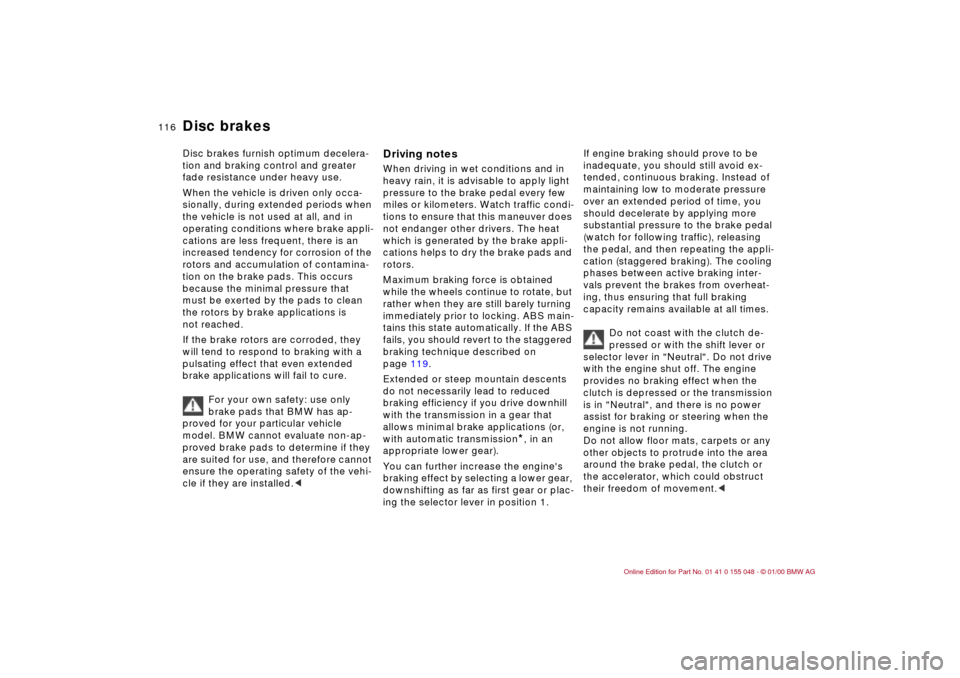
116n
Disc brakesDisc brakes furnish optimum decelera-
tion and braking control and greater
fade resistance under heavy use.
When the vehicle is driven only occa-
sionally, during extended periods when
the vehicle is not used at all, and in
operating conditions where brake appli-
cations are less frequent, there is an
increased tendency for corrosion of the
rotors and accumulation of contamina-
tion on the brake pads. This occurs
because the minimal pressure that
must be exerted by the pads to clean
the rotors by brake applications is
not reached.
If the brake rotors are corroded, they
will tend to respond to braking with a
pulsating effect that even extended
brake applications will fail to cure.
For your own safety: use only
brake pads that BMW has ap-
proved for your particular vehicle
model. BMW cannot evaluate non-ap-
proved brake pads to determine if they
are suited for use, and therefore cannot
ensure the operating safety of the vehi-
cle if they are installed.<
Driving notesWhen driving in wet conditions and in
heavy rain, it is advisable to apply light
pressure to the brake pedal every few
miles or kilometers. Watch traffic condi-
tions to ensure that this maneuver does
not endanger other drivers. The heat
which is generated by the brake appli-
cations helps to dry the brake pads and
rotors.
Maximum braking force is obtained
while the wheels continue to rotate, but
rather when they are still barely turning
immediately prior to locking. ABS main-
tains this state automatically. If the ABS
fails, you should revert to the staggered
braking technique described on
page 119.
Extended or steep mountain descents
do not necessarily lead to reduced
braking efficiency if you drive downhill
with the transmission in a gear that
allows minimal brake applications (or,
with automatic transmission
*, in an
appropriate lower gear).
You can further increase the engine's
braking effect by selecting a lower gear,
downshifting as far as first gear or plac-
ing the selector lever in position 1.If engine braking should prove to be
inadequate, you should still avoid ex-
tended, continuous braking. Instead of
maintaining low to moderate pressure
over an extended period of time, you
should decelerate by applying more
substantial pressure to the brake pedal
(watch for following traffic), releasing
the pedal, and then repeating the appli-
cation (staggered braking). The cooling
phases between active braking inter-
vals prevent the brakes from overheat-
ing, thus ensuring that full braking
capacity remains available at all times.
Do not coast with the clutch de-
pressed or with the shift lever or
selector lever in "Neutral". Do not drive
with the engine shut off. The engine
provides no braking effect when the
clutch is depressed or the transmission
is in "Neutral", and there is no power
assist for braking or steering when the
engine is not running.
Do not allow floor mats, carpets or any
other objects to protrude into the area
around the brake pedal, the clutch or
the accelerator, which could obstruct
their freedom of movement.<
Page 117 of 199
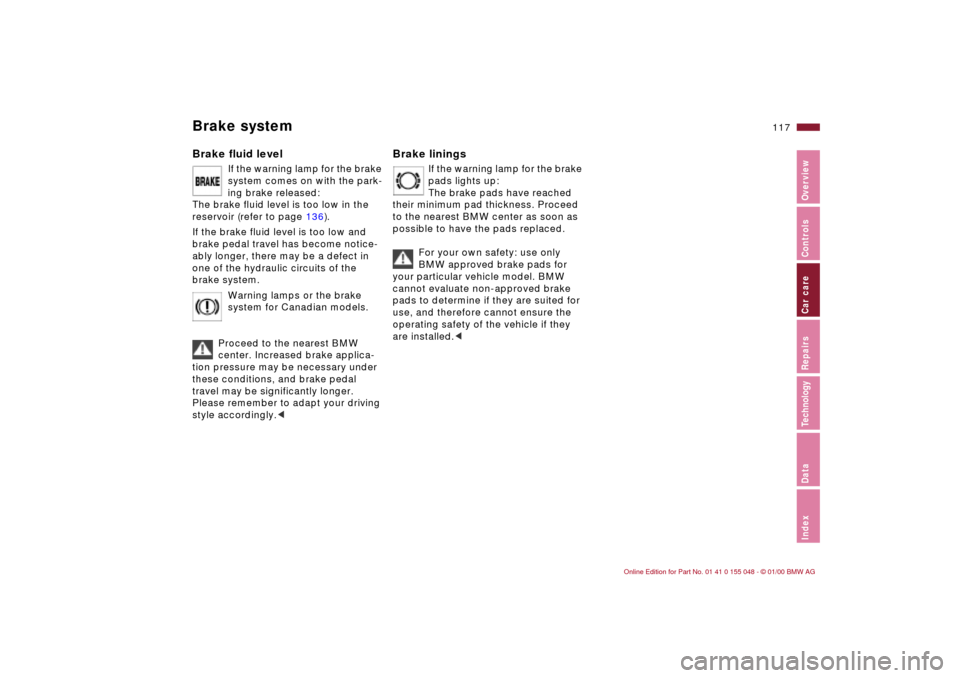
117n
IndexDataTechnologyRepairsCar careControlsOverview
Brake systemBrake fluid level
If the warning lamp for the brake
system comes on with the park-
ing brake released:
The brake fluid level is too low in the
reservoir (refer to page 136).
If the brake fluid level is too low and
brake pedal travel has become notice-
ably longer, there may be a defect in
one of the hydraulic circuits of the
brake system.
Warning lamps or the brake
system for Canadian models.
Proceed to the nearest BMW
center. Increased brake applica-
tion pressure may be necessary under
these conditions, and brake pedal
travel may be significantly longer.
Please remember to adapt your driving
style accordingly.<
Brake linings
If the warning lamp for the brake
pads lights up:
The brake pads have reached
their minimum pad thickness. Proceed
to the nearest BMW center as soon as
possible to have the pads replaced.
For your own safety: use only
BMW approved brake pads for
your particular vehicle model. BMW
cannot evaluate non-approved brake
pads to determine if they are suited for
use, and therefore cannot ensure the
operating safety of the vehicle if they
are installed.<
Page 136 of 199
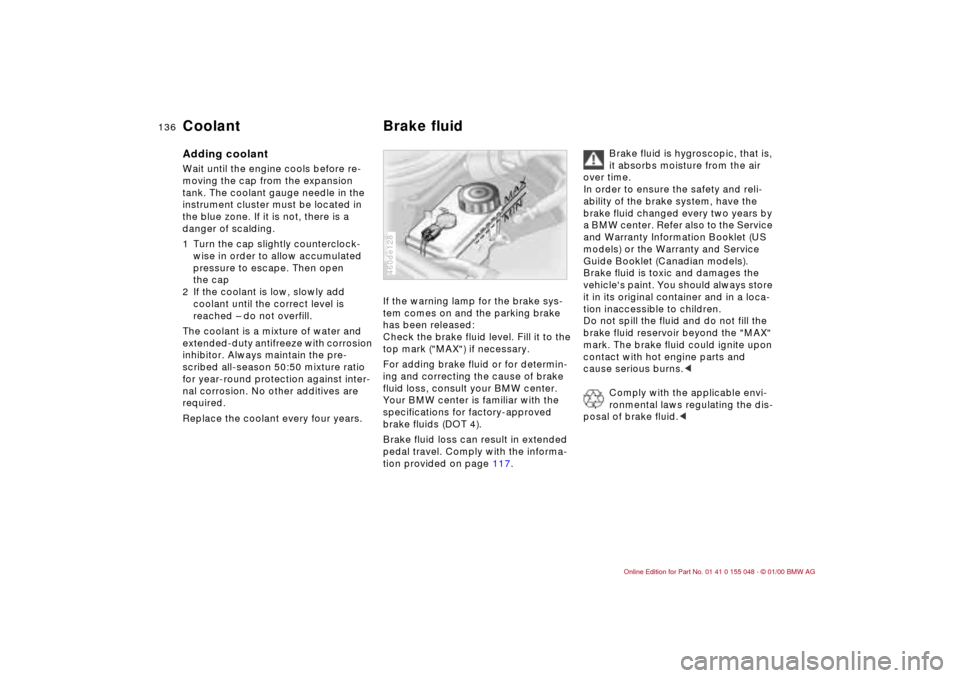
136n
Coolant Brake fluidAdding coolant Wait until the engine cools before re-
moving the cap from the expansion
tank. The coolant gauge needle in the
instrument cluster must be located in
the blue zone. If it is not, there is a
danger of scalding.
1 Turn the cap slightly counterclock-
wise in order to allow accumulated
pressure to escape. Then open
the cap
2 If the coolant is low, slowly add
coolant until the correct level is
reached – do not overfill.
The coolant is a mixture of water and
extended-duty antifreeze with corrosion
inhibitor. Always maintain the pre-
scribed all-season 50:50 mixture ratio
for year-round protection against inter-
nal corrosion. No other additives are
required.
Replace the coolant every four years.If the warning lamp for the brake sys-
tem comes on and the parking brake
has been released:
Check the brake fluid level. Fill it to the
top mark ("MAX") if necessary.
For adding brake fluid or for determin-
ing and correcting the cause of brake
fluid loss, consult your BMW center.
Your BMW center is familiar with the
specifications for factory-approved
brake fluids (DOT 4).
Brake fluid loss can result in extended
pedal travel. Comply with the informa-
tion provided on page 117.
460de128
Brake fluid is hygroscopic, that is,
it absorbs moisture from the air
over time.
In order to ensure the safety and reli-
ability of the brake system, have the
brake fluid changed every two years by
a BMW center. Refer also to the Service
and Warranty Information Booklet (US
models) or the Warranty and Service
Guide Booklet (Canadian models).
Brake fluid is toxic and damages the
vehicle's paint. You should always store
it in its original container and in a loca-
tion inaccessible to children.
Do not spill the fluid and do not fill the
brake fluid reservoir beyond the "MAX"
mark. The brake fluid could ignite upon
contact with hot engine parts and
cause serious burns.<
Comply with the applicable envi-
ronmental laws regulating the dis-
posal of brake fluid.<
Page 139 of 199

139n
IndexDataTechnologyRepairsCar careControlsOverview
Washing your vehicle You can wash your BMW at an auto-
matic car wash, even when it is new.
Brushless systems are preferable (refer
to page 144 as well).
Wipe away tough dirt and loosen and
remove dead insects before washing
the vehicle.
In order to avoid spots, do not wash the
vehicle when the hood is warm, or dur-
ing or immediately after exposure to
strong sunlight.
When using an automatic car wash, be
sure that:
>The car wash system is suited for the
dimensions of your vehicle
>No damage will occur to vehicles
with attached body accessories (such
as spoilers or antennas). Consult the
car wash operator if necessary
>The wheels and tires of your vehicle
cannot be damaged by the convey-
ance devices of the car wash system
>The vehicle is cleaned with minimum
brush pressure, and that ample water
is available for washing and rinsing.Vehicles with rain sensor
*:
Clean the windshield regularly. Wax
from automatic car washes or insects
can cause the rain sensor* to malfunc-
tion.
Turn the rain sensor* off (refer to
page 78) when passing through an
automatic car wash. Failure to do so
could result in damage caused by unin-
tended wiper activation.<
Parts of the vehicle that are inaccessi-
ble to the automatic washer – such as
door sills, door and hood edges, etc. –
should be cleaned by hand.
In the winter months, it is especially im-
portant to ensure that the vehicle is
washed on a regular basis. Large quan-
tities of dirt and road salt are difficult to
remove, and they also damage the
vehicle.
If spray wands or high-pressure
washers are used, be sure to
maintain an adequate distance between
the spray source and the vehicle's sur-
face. Inadequate distance and exces-
sive pressure can damage or weaken
the finish, making it more susceptible to
subsequent attack. In addition, mois-
ture could penetrate to vehicle compo-
nents, leading to long-term damage.<
When cleaning the headlamps,
please observe the following:
Do not clean by wiping with a dry cloth
(scratches). Never use abrasives or
strong solvents to clean the covers.
Remove dirt and contamination (such
as insects) by soaking with BMW Car
Shampoo and then rinsing with plenty
of water. Always use a deicer spray to
remove accumulated ice and snow –
never use a scraper.<
After washing the vehicle, apply
the brakes briefly to dry them.
Braking efficiency might otherwise be
reduced by the moisture and the brake
rotors could also corrode.<
Caring for your vehicle
Page 140 of 199
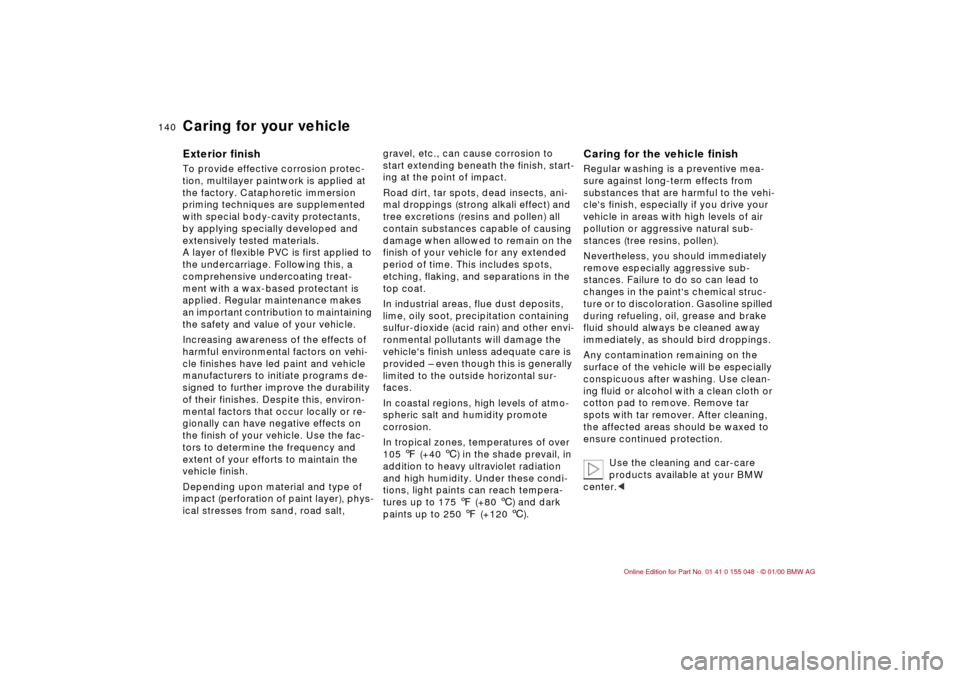
140n
Caring for your vehicleExterior finish To provide effective corrosion protec-
tion, multilayer paintwork is applied at
the factory. Cataphoretic immersion
priming techniques are supplemented
with special body-cavity protectants,
by applying specially developed and
extensively tested materials.
A layer of flexible PVC is first applied to
the undercarriage. Following this, a
comprehensive undercoating treat-
ment with a wax-based protectant is
applied. Regular maintenance makes
an important contribution to maintaining
the safety and value of your vehicle.
Increasing awareness of the effects of
harmful environmental factors on vehi-
cle finishes have led paint and vehicle
manufacturers to initiate programs de-
signed to further improve the durability
of their finishes. Despite this, environ-
mental factors that occur locally or re-
gionally can have negative effects on
the finish of your vehicle. Use the fac-
tors to determine the frequency and
extent of your efforts to maintain the
vehicle finish.
Depending upon material and type of
impact (perforation of paint layer), phys-
ical stresses from sand, road salt, gravel, etc., can cause corrosion to
start extending beneath the finish, start-
ing at the point of impact.
Road dirt, tar spots, dead insects, ani-
mal droppings (strong alkali effect) and
tree excretions (resins and pollen) all
contain substances capable of causing
damage when allowed to remain on the
finish of your vehicle for any extended
period of time. This includes spots,
etching, flaking, and separations in the
top coat.
In industrial areas, flue dust deposits,
lime, oily soot, precipitation containing
sulfur-dioxide (acid rain) and other envi-
ronmental pollutants will damage the
vehicle's finish unless adequate care is
provided – even though this is generally
limited to the outside horizontal sur-
faces.
In coastal regions, high levels of atmo-
spheric salt and humidity promote
corrosion.
In tropical zones, temperatures of over
105 7 (+40 6) in the shade prevail, in
addition to heavy ultraviolet radiation
and high humidity. Under these condi-
tions, light paints can reach tempera-
tures up to 175 7 (+80 6) and dark
paints up to 250 7 (+120 6).
Caring for the vehicle finish Regular washing is a preventive mea-
sure against long-term effects from
substances that are harmful to the vehi-
cle's finish, especially if you drive your
vehicle in areas with high levels of air
pollution or aggressive natural sub-
stances (tree resins, pollen).
Nevertheless, you should immediately
remove especially aggressive sub-
stances. Failure to do so can lead to
changes in the paint's chemical struc-
ture or to discoloration. Gasoline spilled
during refueling, oil, grease and brake
fluid should always be cleaned away
immediately, as should bird droppings.
Any contamination remaining on the
surface of the vehicle will be especially
conspicuous after washing. Use clean-
ing fluid or alcohol with a clean cloth or
cotton pad to remove. Remove tar
spots with tar remover. After cleaning,
the affected areas should be waxed to
ensure continued protection.
Use the cleaning and car-care
products available at your BMW
center.<
Page 191 of 199

Everything from A to Z
191n
IndexDataTechnologyRepairsCar careControlsOverview
Cigarette lighter104
Clock84
Cockpit16
Code, refer to the Radio
Owner's Manual
Coin box, cup holder103
Combination switch77
Compression182
Computer85
Configure settings60
Consumption86
Consumption display83
Convertible top
care144
electrical defect166
Convertible top
compartment panel41
Convertible top operation,
fully automatic convertible
top49
Coolant118, 135, 185
antifreeze118
Coolant temperature
gauge83
Cooling system185
Cornering Brake Control
(CBC)21, 115
Cruise control80
Cruising range86
Curb weight184
Current check indicator20
DDash lighting91
Dashboard16
Data
dimensions183
engine182
technical182
weights184
Daytime-driving lamp
switch91
Defrost setting97
Defrosting the
windows97, 98
Digital clock84
Dimensions183
Dipstick, engine oil133
Disc brakes116
Displacement182
Display lighting91
Displays18
Distance warning87
Diversity Antenna174
Door key32
Door locks, care118
Doors
emergency actuation34
remote control35
unlocking and locking34
Drive belts186
Driving hints113
Driving in winter118Driving lamps91
DSC (Dynamic Stability
Control)22, 88, 173
EElectric power windows44
Electrical accessories,
failure165
Electrical system186
Electronic vehicle
immobilizer33
Elements of operation16
Emergency actuation
doors34
fuel filler door165
fully automatic convertible
top166
Emergency closure166
Energy Control82
Engine compartment130
Engine coolant135, 185
Engine data182
Engine oil
capacity185
consumption133
pressure20
quality134
specifications134
viscosity134
Engine oil level21
check133Engine speed182
Engine, starting70
Entry to the rear56
Exterior mirrors58
Eyes169
FFailure messages84
Fault displays84
Fault, ABS115
Filler cap cover26
Filling capacities185
Filling the washer
reservoir185
First-aid kit25
Flashlight99
Flat tire123, 159
Fog lamps92
bulb replacement155
"Follow-Me-Home"
lamps91
Footbrake116
Footwell lamps92
bulb replacement158
Front seat adjustment53
Frost protection,
radiator135
Fuel27
gauge83
preparation182
quality27
Fuel consumption86
Page 192 of 199
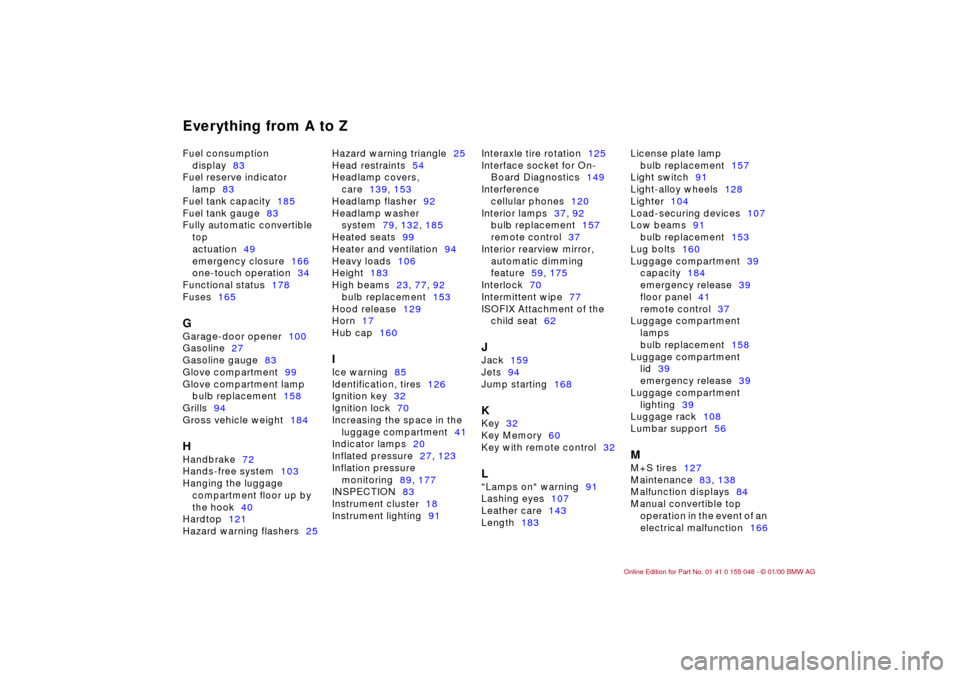
Everything from A to ZFuel consumption
display83
Fuel reserve indicator
lamp83
Fuel tank capacity185
Fuel tank gauge83
Fully automatic convertible
top
actuation49
emergency closure166
one-touch operation34
Functional status178
Fuses165GGarage-door opener100
Gasoline27
Gasoline gauge83
Glove compartment99
Glove compartment lamp
bulb replacement158
Grills94
Gross vehicle weight184HHandbrake72
Hands-free system103
Hanging the luggage
compartment floor up by
the hook40
Hardtop121
Hazard warning flashers25Hazard warning triangle25
Head restraints54
Headlamp covers,
care139, 153
Headlamp flasher92
Headlamp washer
system79, 132, 185
Heated seats99
Heater and ventilation94
Heavy loads106
Height183
High beams23, 77, 92
bulb replacement153
Hood release129
Horn17
Hub cap160
IIce warning85
Identification, tires126
Ignition key32
Ignition lock70
Increasing the space in the
luggage compartment41
Indicator lamps20
Inflated pressure27, 123
Inflation pressure
monitoring89, 177
INSPECTION83
Instrument cluster18
Instrument lighting91Interaxle tire rotation125
Interface socket for On-
Board Diagnostics149
Interference
cellular phones120
Interior lamps37, 92
bulb replacement157
remote control37
Interior rearview mirror,
automatic dimming
feature59, 175
Interlock70
Intermittent wipe77
ISOFIX Attachment of the
child seat62
JJack159
Jets94
Jump starting168KKey32
Key Memory60
Key with remote control32L"Lamps on" warning91
Lashing eyes107
Leather care143
Length183License plate lamp
bulb replacement157
Light switch91
Light-alloy wheels128
Lighter104
Load-securing devices107
Low beams91
bulb replacement153
Lug bolts160
Luggage compartment39
capacity184
emergency release39
floor panel41
remote control37
Luggage compartment
lamps
bulb replacement158
Luggage compartment
lid39
emergency release39
Luggage compartment
lighting39
Luggage rack108
Lumbar support56
MM+S tires127
Maintenance83, 138
Malfunction displays84
Manual convertible top
operation in the event of an
electrical malfunction166